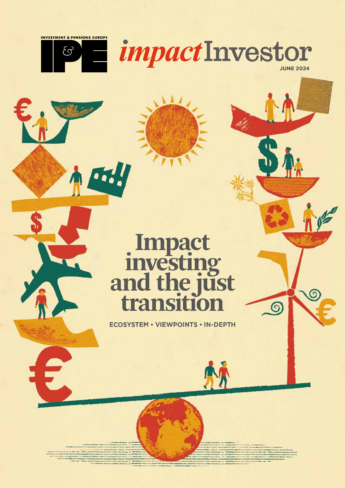From strategies that prioritise local impact, to those focused on emerging markets, European pension funds are upscaling their commitments to investments where impact and returns can go hand-in-hand as ABP, Railpen and PostNL tell us.

ABP, Netherlands – Martin van der Pot, senior investment adviser:
ABP takes a proactive approach to impact investing. We aim to invest €30bn into impact by 2030.

We want to be quite strict, focusing on the theory of change and on real world outcomes. For investments that we label as impact we want to have clear evidence to substantiate this.
Over the next seven years we will invest over €10bn in climate solutions, and €1bn in biodiversity, while €10bn will be allocated to impact investing in the Netherlands, focused on affordable housing, sustainable energy and innovation. We define impact investing as intentional, measurable, additional investments that provide both financial and societal profits.
We expect the vast majority of these allocations to be in private markets. We currently don’t foresee public market investments because the theory of change is difficult to implement there.
We don’t label investments made prior to 2023 as impact. It could be that they are impact – for example with the wind generation we already have in our portfolio – but we didn’t have the documented intention of making a specific impact, and you can’t go back and place that intention afterwards.
One of the challenges we face is finding the right investments in a competitive landscape. An important reason for this is that other investors might have other impact definitions or themes and we will not be fully aligned. Some of our investments are directly managed, like infrastructure, so it’s less of an issue. Real estate is also partly directly managed. But we are also aiming to do a lot of impact in the private equity space, and that is fully externally managed. The challenge is most pronounced in private equity because there can be a lot of investors in a fund which is commonly a blind pool at the onset when you commit to invest. You don’t know the exact investments that will end up in the fund and have to rely on the philosophy of the manager and past examples.
Another challenge is around biodiversity because biodiversity in itself is typically not a business model. There are a lot of business models that harm biodiversity, but to positively add to biodiversity while making a good financial return is much more difficult to do. If you have forest lands, for example, the best thing you can do is conserve it. But making a profitable business model out of that is difficult. This is a case where it will probably be necessary to have a mix of positive impact, but also significantly reduce the negative impact compared to comparable projects.
In the public space, we are not aiming for impact but are going from exclusion to inclusion, with a tailor-made index. We are also limiting the number of companies we invest in. Both inclusion and index investing are big shifts for ABP that we announced in March.
Companies where climate or biodiversity damage is inherently linked to their business activities, with no realistic prospect of improvement, do not fit within ABP’s equity portfolio. ABP expects companies with a significant impact on climate to present concrete plans for reducing emissions in the coming years. Also, companies should make efforts to manage risks regarding biodiversity. So, what is happening in the private space and the public space complement each other.
Railpen, UK – Emma Barry, external communications manager:
We don’t describe ourselves, or our approach, as ‘impact investors’, however, we integrate material sustainability considerations into our investment decisions, including prioritising investments that provide financial returns for the Railways Pension Scheme members by being well-placed to manage the risks and opportunities arising from issues such as climate change or demographic shifts.

We consider opportunities which align with our sustainability and governance priorities, such as supporting climate action, promoting energy efficiency, investing in essential infrastructure, fostering innovation, and enhancing workplace and community wellbeing.
We conduct in-depth analysis to ensure investments are aligned with our trustees’ investment beliefs and utilise tools to identify and address ESG risks specific to different asset classes.
We have four thematic stewardship priorities: the climate transition, worth of the workforce, responsible technology and sustainable financial markets.
Railpen is a multi-asset investor across a full spectrum of public and private markets, real assets and infrastructure, and whilst our thematic priorities are the same, our approach differs depending on the asset class.
With public and private markets, we consider and prioritise our engagement activities with companies based on an ESG materiality matrix, considering both systemic and idiosyncratic risks and opportunities. This enables us to identify and prioritise companies and areas where we feel we can most usefully influence corporate behaviour in members’ best interests, for example, how companies treat their employees, how companies manage and mitigate environmental risks, or how companies consider responsible technology and cyber security.
Within infrastructure and real assets, our approach differs to reflect the direct involvement we have with these assets and the communities surrounding them. For new real assets, we develop value creation plans which enable us to effectively identify areas where we can have a greater impact, as well as create a benchmark for measuring and managing this.
Whilst Railpen does not allocate capital based on impact, it is an interesting research area which we continue to learn about. Based on our observations, some of the biggest challenges when considering impact investing include effective measurements and metrics – quantifying the impact, particularly where this can be subjective and difficult to standardise.
This is particularly relevant when considering social impact, where it is important to be able to demonstrate meaningful societal benefits and avoid ‘impact washing’. Scalability is also a challenge, requiring collaboration amongst investors, policymakers, businesses and society in order to improve access to capital for sustainable and impactful projects and foster a supportive ecosystem for sustainable investing.
PostNL, Netherlands – Rene van de Kieft, chairman:
Pensioenfonds PostNL started impact investing in several asset classes a few years ago. We started with best-in-class and SDG-aligned investing, with a focus on the sustainability themes of the pension fund, namely health and wellbeing and climate.
In order to make a greater impact, we decided to start investing a small portion of our portfolio in pure impact, beginning with farmland investments by creating a bespoke solution with clear KPIs.

This small portion was intentionally done, mainly because the actual measurement and added value of impact investment opportunities was still in its early stages.
In recent years, PostNL has established its own impact criteria that impact investments must contribute to, based on real-world impact indicators.
We are currently in the process of developing a robust impact framework across asset classes because we see different degrees of impact within the definition of impact. For example, there are impact investments that align with the energy transition (brown to green), and there are impact investments that are purely green (with a direct intention/additionality to deliver positive impact). Both are important and both will require different indicators to monitor their impact.
Since 2021, impact investing has been applied for a large part of our farmland portfolio, as well as in a hybrid SDG/impact solution within equities and corporate green bonds. This year, PF PostNL will research and determine the extent to which impact investments can be incorporated within private debt and private real estate.
An important theme in this regard is local investments, in addition to the health and wellbeing and climate themes that are central to the overall portfolio of the pension fund.
After extensive analysis, the pension fund decided to reduce investments in emerging markets. An important consideration in this decision was the combination of geopolitical risks and relatively limited risk premium for these risks.
Additionally, there are ample investment opportunities in developed markets with lower risk. Within the impact category of farmland, for example, the fund had already chosen to invest only in developed countries.
Our pension fund has prioritised investments that generate a positive impact closer to home, recognising the need to take steps considering our economic prosperity and the impact we have on the climate.
When it comes to impact, the main challenge lies in engaging underlying managers and companies to provide accurate data on the indicators used for measuring impact. There are different methods for assessing impact, but the objective is to standardise impact data as much as possible. This will allow for a comprehensive view of the overall impact of the entire portfolio at an aggregated level.
With the evolving regulatory landscape, it is evident that progress in this area is accelerating rapidly, leading to improved availability and quality of impact data. This enables our pension fund to set more ambitious goals and effectively track the impact we strive to achieve, aligning with our sustainability theme.

This article is part of the ‘Impact Investing and the Just Transition’ report, a collaboration between Impact Investor and our sister publications IPE and IPE Real Assets.
You can download a digital copy of the report here.






